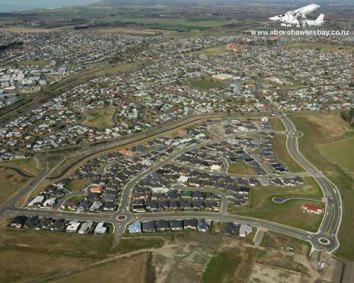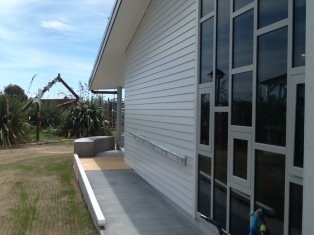Activity 2: Current issues in my professional context
The culture of a school is shaped by its history and is situationally unique Stoll (1998). Our school was opened in 1975 on land which was uplifted by the 1931 Napier earthquake. It is reported that between 1 – 2 meters was uplifted. This aerial photo shows the suburb of Tamatea and the construction of more suburbs on reclaimed land in the area.
Haka o Tamatea
“No hea te kapa e tu nei – no te ti no te ta – hi”

The photo below shows how in times of heavy rainfall our area is susceptible to major flooding as it is so low-lying.

Our school was named after Tamatea Pokai Whenua. His grandfather was Tamatea Ariki Nui who captained the Takitimu waka to Aotearoa.
Today our kura is 45% Maori and is a decile 4.
“Na Tamatea Pokai-Whenua I – hiki-ake te whenua e – Ki runga ia Papatuanuku e i a ha ha – hi”
In the video ‘Building a culture of success’ (2013) Mark Wilson speaks about the success of a school being dependent on the vision and the unity which surrounds it. An important question for our school in recent times was to ask ‘who are we’? Over a number of years the cultural history of our school and its whakapapa had been lost. We were a lot of individuals without a special bond – teaching staff, learners, and our community. As Stoll (1998) describes, our culture was one of individualism. It was time to reclaim who we were – who we are. Over more recent times the teaching culture within our school has seen a move towards one of collaboration. It was time to listen, time to seek the knowledge from within our rohe of Kahungunu. Time to see the value of shared expertise.
“Taringa whakarongo e! Aroha mai ra ki ahau, ki te rangatahi, e tu nei, e kimi ana i te matauranga i roto i te rohe o Kahungunu”
An important connection for our tamariki is who Tamatea Pokai Whenua was and what his connection is with our whanau now.
His son was Kahungunu.
For all our stakeholders it was important to reconnect them to the whakapapa of our school. Our new logo brings back the original figures of Tamatea Pokai Whenua, his father Rongokako, and his grandfather Tamatea Ariki Nui.

“E tatou e te rangatahi, kei hea ra te rongoa”
Building a culture of success has taken some reculturing (Stoll, 1998). While history doesn’t change, mindsets, visions, and paradigms do. The systematic reform we are in the process of going through now involves the building of new conceptions of what instruction is. You could say the climate or personality of our school is changing (2015). We are beginning to realise that the environment we cultivate, that working together rather than in isolation, and through understanding each other we can move forward in unity.
“Kei a tatou tonu! Kei a tatou tonu! Kei roto i a tatou mahi, kei roto i a tatou Korero, engari, me mahi tahi tatou, me awhinatia tatou i a tatou, ki te kimihia i te matauranga hei oranga mo o matou tinana e – Hi!”
This year saw Tamatea open the doors to a new Innovative Learning Environment (ILE). The personality of our school will continue to change with the empowerment of our learners. Empowerment leads to engagement and engagement leads to autonomy. Self determination or Tino Rangatiratanga is one of the principals of kaupapa Maori and important for us as we aim to transform outcomes for Maori and have Maori achieve success as Maori.
Appropriately, our ‘parent’ ILE is named after Tamatea Pokai Whenua’s mother and father – Muriwhenua and Rongokako. By using the names of our community whakapapa we hope to make connections for our tauira giving them a sense of belonging.


The words of our school haka are woven through this post. This haka was written by my husband for our school – to give our kura a sense of its own identity. The kupu speak about the coming together of the people in our learning community, to understand the whakapapa of our kura, to be united in the kaupapa – in order for our youth to find success through self determination.
Academy for SELinSchools. ( 2015, Apr 28).What is school culture and climate? .Retrieved from https://www.youtube.com/watch?v=Z-_NvhlcusQ
Stoll. (1998). School Culture. School Improvement Network’s Bulletin 9. Institute of Education, University of London. Retrieved from http://www.educationalleaders.govt.nz/Culture/Understanding-school-cultures/School-Culture
TEdEd.(2013, Jun 21). Building a culture of success- Mark Wilson.. Retrieved from https://www.youtube.com/watch?v=n_8Bjz-OCD8
Principals of Kaupapa Maori retrieved from: http://www.rangahau.co.nz/

Hi Kerri, our school too has a rich history dating back to 1927 and it is very much embedded in our community- parents, boys and staff. I believe it adds such a lovely undertone to the school culture, climate and community when there is that shared respect and understanding of the school’s roots.
Cool to hear you feel that you feel the staff are coming to their own realisations about working together and coming together for a common goal- something I think can’t be forced.
Nice reflection. 🙂
LikeLike
Beautiful reflection, Kerri. Your school has a proud history and I hope that reconnecting to your roots will continue to inspire everyone involved with the school – parents, students and staff. By staying true to our roots, we’ll grow wings to fly. I think its is important for the school to have an identity for without it, it’ll be hard for anyone to develop a sense of belonging/attachment to it. All the best.
LikeLike
Thank you Joseph for leaving me a comment. I think having listened to Markus Akuhata Brown speak about the importance of connections really resonated and pushed me to reignite the whakapapa our school should be proud of … for the sake of everyone but mostly to our learners who connect with this area.
LikeLike